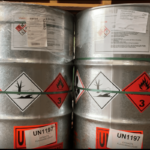Dangerous Goods (DG) are items that are a risk to health, safety, property or the environment when transported.
Did you know that dangerous goods which pose a risk even when not being transported are known as hazardous material (HAZMAT)?
The following goods are classed as dangerous:
- Explosives
- Gases
- Flammable liquids
- Flammable solids
- Oxidizers
- Organic Peroxides
- Toxic substances
- Infectious substances
- Radioactive material
- Corrosive substances
Packaging
Packaging must be UN-approved. This means that it has been designed and constructed to the specification standards of the UN. They have to pass certain tests such as being dropped, stacked or put under pressure.
Before you order any packaging make sure that the packaging supplier sends you: a copy of the certificate, information on how to use the packaging properly and any packaging test reports.
If you need advice on dangerous goods packaging, contact the VCA dangerous goods office on 01372 226 110.
Labelling
Dangerous goods MUST be labelled with the appropriate hazard symbols, warnings and safety advice. Please note, that labelling requirements can vary between countries.
Handling
If your business handles, processes or transports dangerous goods you must appoint a qualified Dangerous Goods Safety Advisor. Their role is to monitor compliance with safety measures when transporting dangerous goods. They will investigate any related accidents and should prepare an annual report.
Documentation
All dangerous goods must be accompanied by the correct documentation identifying what the products are. The driver should have or know where to get, a copy of the safety data sheets of the goods being transported.
Shipping
Shipping requirements vary depending on transport type; by road, rail, inland waterway, sea or air, with different authorities responsible for governing each method.
Responsibility
The consignor (the sender of the goods) is responsible for ensuring that the goods are classified, labelled, packed and identified correctly. However, when it comes to the actual movement of the goods, many of the regulations apply to all involved those who ‘allow dangerous goods to be transported.
Limited Quantities
If you are transporting limited quantities, you don’t need to follow certain packaging and labelling regulations, and you do not need a dangerous goods safety adviser.
Transporting goods of this nature by road is called ADR transport. This acronym stands for Accord Dangereux Routier which is the European regulations concerning the international carriage of dangerous goods by road.
We can carry class 2 up to and including class 8. We also can store hazardous goods too.
For any help on transporting goods of this kind please contact us on 01384 221642 or email info@jjxlogistics.co.uk

We're ready when you need us

